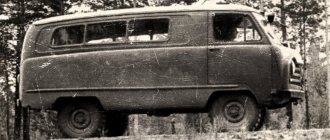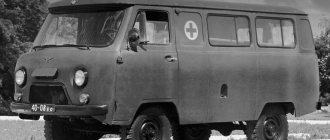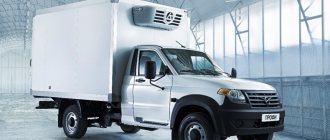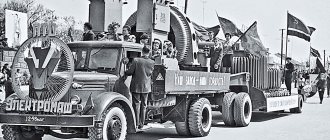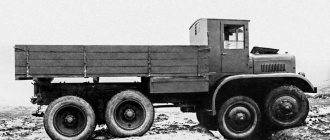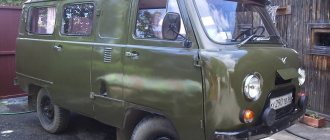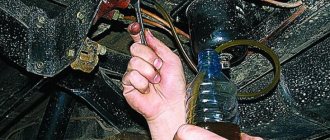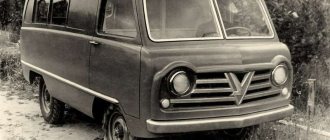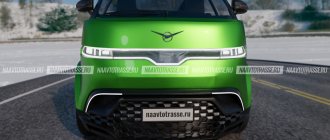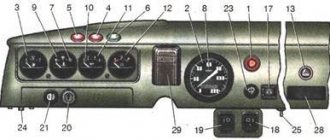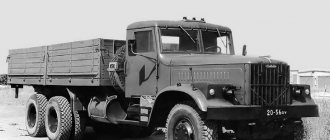Author: SellAvi
22 January 2022 14:53
Tags: auto loaf do it yourself tuning UAZ
29278
32
“Loaf” - this unsightly-looking car, produced by the Ulyanovsk enterprise in various variations, has long and firmly taken its place in the economic life of the state. It is worth considering that good modernization potential, coupled with not the highest cost, definitely contributes to transformation, and many are not stopped even by global changes.
0
See all photos in the gallery
Wheels and tires are the first area into which the owner invades. Moreover, such changes are provoked not only by the desire for tuning, but also by the wheels and tires themselves installed at the factory. Some owners simply want to replace this grayness with something more stylish by installing alloy kits. Others prepare the car for the trophy, equipping it with wheels that can overcome off-road conditions, confidently crushing sand and clay. However, the wheel arches are not designed for such toothy kits. Consequently, it is necessary to make changes: transforming the outlines of the arches is a rather labor-intensive and time-consuming option, involving bodywork and painting work; a car lift is much more popular, because it allows you not only to install the wheels of your dreams, but also to increase ground clearance.
0
Plain gray or boring green colors do not suffer from excessive showiness. Whether it's the khaki color, made in army style! If there is a desire to make the “Loaf” clearly visible on the road, they resort to another method - repainting it in bright colors (red, blue, yellow, orange and others). Even the photo of the UAZ “Bukhanka” tuning, made in a similar style, attracts attention.
×
0
If a car is preparing to conquer off-road conditions, then winches installed at the front and rear (electric or mechanical) are a must. They will help pull out stuck vehicles. Also, a powerful spotlight is absolutely necessary on the roof, and fog lights are required on the bumper - additional optics will ensure that you can see the road at dusk. Regarding the spare wheel, it requires the adaptation of another bracket in order to prevent the fifth door from sagging, since the wheel will be noticeably larger and heavier than the standard one. A couple of spare wheels would also come in handy.
0
Ideally, tuning the UAZ 452 Bukhanka requires an immediate replacement of the engine, since the standard 112-horsepower engine is too weak. For this, either a unit from a foreign bus or a domestic one can be used. The installation of a diesel ZMZ-514 looks very attractive, which will provide: - good traction; — impressive efficiency; - acceptable dynamics. However, this is not cheap, and besides, a large, 16-valve diesel engine cannot easily fit into the narrow engine compartment of a UAZ - it rests against the panel with a cast intake tract receiver. You will have to bend the panel a little and weld it, but the effort is worth it. If it is not possible to replace the engine, you will have to chip the gasoline engine, but you will need to find a qualified technician. However, you can’t expect miracles - the tuner can only make the engine a little more flexible, more economical and reduce the amount of harmful emissions. However, no significant increase in power is expected.
UAZ-450B - headquarters on wheels
In 1956, the Ulyanovsk Automobile Plant received a special order from the Automotive Directorate of the Armed Forces of the USSR to develop a mobile headquarters based on the first independent series of the automobile plant's model - the UAZ-450. The new product was called UAZ-450B and three prototypes were produced for testing.
Prototype headquarters on wheels UAZ-450B
Externally, the newly-made headquarters on wheels was no different from the basic UAZ-450 model, but the interior had a complete set for performing the functions assigned to the vehicle: folding tables with table lamps, a clock and additional autonomous heaters in case of need to work in severe frost. There was even a safe in the cabin of the UAZ-450B for storing documents.
Tests showed that there was not enough space in the interior of the headquarters minibus, so all work on this project was stopped.
Bus 2206
Thanks for subscribing! Further instructions have been sent to your email.
The lineup
- UAZ Profi
- UAZ Profi with double-row cab
- UAZ Pro with add-ons
- Classic commercial range
For buyers
- Cars in stock
- Configurator
- Dealer centers
- Special offers
- UAZ Finance
- Free test drive
- to corporative clients
Owners
- Personal Area
- Special offers
- Buy spare parts
- Service stations
- Maintenance Calculator
- Warranty service
- Manuals and instructions
- Checking for service campaigns
- UAZ oils and operating fluids
- Original UAZ consumables
- UAZ PROFI Assistance: Roadside assistance
UAZ World
- Classic UAZ family
- UAZ clothing store
- News
- Press about us
- Story
- Contacts
- Become a dealer
- Trips
- 75 years of UAZ
2019 © Ulyanovsk Automobile Plant Site map Feedback form Press center: eng
* — RRP is valid when purchasing a new car, taking into account a discount of 6% from the base cost of the car when purchasing under the UAZ-Leasing program. The program is valid until January 31, 2022 The number of cars participating in the promotion is limited, details in the showrooms of official UAZ dealers
“UAZ “Bukhanka” on credit for 11,1461 rubles per month” 1 -Monthly payment is achieved under the following conditions: purchase of a new UAZ “Bukhanka” car at a price of 711,900 rubles. on credit for a period of 60 months at a rate of 12.9% per annum; down payment 284,760 rub. The loan is provided by PJSC VTB Bank (hereinafter referred to as the “Bank”). The specified interest rate in the loan agreement is achieved within the framework of the AutoLight program, subject to the execution of a voluntary personal insurance agreement/policy with one of the insurance companies that meets the Bank's requirements for insurance companies listed on the website vtb.ru. Without drawing up a voluntary personal insurance agreement/policy with one of the insurance companies that meets the Bank’s requirements for insurance companies listed on the website vtb.ru. the interest rate will be 15.9% Basic conditions of the AutoLight car loan program: purchase of a new car of foreign or domestic production. Down payment from 20% of the cost of the car. Loan term 1–5 years. The interest rate is 12.9%, subject to the execution of a voluntary personal insurance agreement/policy with one of the insurance companies that meets the Bank’s requirements for insurance companies listed on the website vtb.ru. Without drawing up a voluntary personal insurance agreement/policy with one of the insurance companies that meets the Bank’s requirements for insurance companies listed on the website vtb.ru. - 15.9%. The loan currency is rubles. Loan amount from 300,000 to 5,000,000 rubles. Mandatory insurance of collateral is carried out in accordance with the tariffs of the insurance company. The loan is repaid with monthly annuity payments. In case of untimely fulfillment of obligations to repay the loan and/or pay interest, commissions, the borrower pays a penalty in the form of a penalty in the amount of 0.1% per day of the amount of unfulfilled obligations. Full terms and conditions are available on the website vtb.ru. The conditions are valid as of December 28, 2018. VTB Bank (PJSC) does not sell cars on a commercial basis, and also does not carry out insurance activities. General license of the Bank of Russia No. 1000. Advertising.
All information presented on the site regarding cars and service is for informational purposes only and is not a public offer as defined by the provisions of Art. 437 (2) Civil Code of the Russian Federation. All prices indicated on this website are for informational purposes and are the maximum permissible prices according to calculations). For detailed information, please contact your nearest official UAZ LLC dealer. Information published on this site is subject to change at any time without prior notice.
UAZ-452 - fitting room
The UAZ company shared this photo on social networks, saying that the photo was found in the corporate archive. Even the modern office of the Ulyanovsk plant was surprised by the fact that such a version of the van based on the “Loaf” existed.
Fitting room based on UAZ-452 “Loaf”
A UAZ-452 all-wheel drive van with single doors on the sides and a double door at the rear was used instead of a fitting room. The photo shows a car with a beige body color with a characteristic orange stripe. The date of the photo is not reported, just as there is no information about the presence of modifications in the salon for the convenience of trying on clothes.
Technical characteristics and filling
SGR - Trophy.
It’s hard to imagine that UAZ will change its engine, so the new “Loaf 2022” will probably be equipped with the previous ZMZ-40911.10 gasoline engine with a volume of 2.693 liters and a power of 112 hp. With. (198 Nm).
If we imagine that the Ulyanovsk residents will be able to implement their plans, which they spoke about last fall, then the new van will be able to count on a 2.5-liter 150-horsepower “aspirated” or a 2.3-liter turbocharged unit, which should produce up to 170 “horses” and 350 Nm of rotating thrust.
UAZ-451C - tracked snowmobile
Developed in 1960, a rare modification of the “Loaf” in the form of an onboard van-snowmobile with triangular rubber-metal tracks on the rear axle and a massive superstructure in the form of steerable skis at the front was used to move through snowy terrain where it was impossible to drive a regular car.
Tuning UAZ-451S: with skis and tracks
In addition to high cross-country ability in snowdrifts, the main feature of the rear-wheel drive UAZ-451C snowmobile was the reversibility of modifications - two people could install the standard chassis back within an hour. Snowmobile parts of the tuned modification, at the same time, could be transported directly in the back of the flatbed.
UAZ-451S with skis and tracks
UAZ-451S with skis and tracks
The total weight of the modified car was 3063 kg, and the maximum speed on snow cover was 20 km/h. How many of these snowmobiles were produced is unknown.
UVZ-2 and UVZ-4.8 with a jet engine
The modifications of the “Loaf”, which later received the names UVZ-2 and UVZ-4.8 (UVZ is an abbreviation for “air launch unit”), are probably the most unusual of all the experimental versions that were created on the basis of this car. At some point, UAZ engineers decided that it would be nice to equip the UAZ-452/3741 van with a rocket engine. No sooner said than done.
Air launch unit UVZ-4.8
It was possible to fit a single-shaft gas turbine engine inside the “Loaf”, but to do this it was necessary to sacrifice all the free space in the body and make significant changes to the usual controls. The steering wheel also began to serve as a gear switch, and instead of the passenger seat in front, engineers placed a control panel for the gas turbine engine and auxiliary equipment for its startup and operation.
Air launch unit UVZ-4.8
The tuned “Loaf” differed from the usual versions of the UAZ-452/3741 from the outside by a massive front bumper and, in combination, a storage tray for a 12-meter flexible hose used to supply compressed air, air intake blinds instead of side windows, a special exhaust hatch on the roof, etc. or - an emergency warning light chandelier. There was also a fire extinguisher located outside the jet car just behind the driver's door.
Air launch unit UVZ-4.8
The list of additional equipment of the “Loaf” with an aircraft engine included a radio station and an automatic fire extinguishing system, which was triggered in the event of a sharp increase in temperature in the cabin. The expensive experimental jet "Loaf" was mainly used for ground-based air starting of aircraft engines (for example, Il-62 and Tu-154). Special vehicles UV3-2 and UV3-4.8 provided the aircraft's air starter turbines with compressed air and fed their on-board electrical network with current.
KMZ-T12.02 – car club
This unusual modification based on the UAZ-3303 SUV was developed during the Soviet era for propaganda work with the goal of communist education of the population. Culture and art were one of the simple ways to form among the population values and ways of thinking that were convenient for the authorities. A convenient means of conveying the necessary thoughts to residents of remote villages was the auto club modification T12.02, which went into mass production in 1987 (however, pre-production versions have existed since 1980).
KMZ-T12.02
Such rotational buses were produced in various modifications, of which the five-seater T12.02, seven-seater T12.02A and eight-seater T12.02B were particularly popular. The equipment of the models varied greatly in composition depending on the specific purpose. All-terrain auto clubs were equipped with tape recorders, film installations, sound amplifiers with acoustics, and photo and video equipment. In such cars, concert groups traveled to remote villages and performed in front of workers and residents of these settlements. Car clubs also brought movies.
KMZ-T12.02
From a technical point of view, auto clubs differed from the base “Kuban” in their larger interior and high ceilings, which also became the reason for their indirect use as a regular means of transportation, which simply became more convenient after tuning. The only fly in the ointment was the separated driver's cabin and interior, which was not to everyone's liking. Because of this, in 1992 the design was revised by removing the wall between the passenger compartment and the driver's cabin. This modification was called TSK2, and auto club versions based on it were TSK2-02 and TSK2-09.
Minibus TSK2
It is interesting that the first versions of auto clubs began to be produced at the Krasnodar Mechanical Plant back in 1967, based on the UAZ-452D chassis, but this design did not take root due to the lack of manufacturability and a low and narrow body. Car clubs T12.02 on the UAZ-3303-1 chassis solved all the shortcomings of the previous base.
Model history
The history of the legendary “Loaf” began in 1958, when the car entered mass production and was officially presented at the All-Union Industrial Exhibition VDNKh.
The first model bore the index UAZ-450. It was nicknamed Bukhanka because of the carriage layout of the body, because the body was immediately made in one piece, and not prefabricated like conventional cars.
With the debut of the classic modification, special versions immediately began to appear: an ambulance, a rural version, an on-board vehicle, and among the most interesting, in 1962, a snowmobile based on the UAZ 451 with tracks and removable skis was designed, and the test version drove from Novosibirsk to Ulyanovsk. You can also note a 16-seater car with a 6x4 wheel arrangement.
The car we are familiar with, the UAZ-452 series, began production in 1965, in 1979 the Bukhanka was slightly updated, and in 1997 it received a new engine under the symbol UMZ-4218 (2.9 l 98 hp). After 11 years, the unit, together with the German company Bosch, was modified and began to comply with Euro-3 standards.
In 2016, the truck was restyled, the dashboard was updated, the seats were replaced with safer and more comfortable ones, sound insulation was improved, and a safety steering wheel was also installed for cargo versions (passenger versions already received it in 2011).
16-seater “Loaf” with a 6x4 wheel arrangement.
UAZ Bukhanka 2022: photo and release date of the completely new UAZ-452
Ten-seater UAZ-37411
Such an experimental model based on the UAZ-37411 was manufactured for the needs of the USSR Ministry of Defense in 1990. When developing the project, the engineers of the Ulyanovsk Automobile Plant were faced with the task of making a car based on the production model, so no deep modifications were carried out.
Ten-seat modification of UAZ-37411 (experimental model)
The roof and sides of the commercial UAZ-37411 were cut off, starting from the driver’s cabin, and the doorways that turned out to be superfluous were welded shut. Two four-seater benches were placed in the cabin, and an awning was supposed to protect passengers from bad weather. To install the latter, a welded frame made of a round pipe was mounted, and to fix the edges of the awning, fastenings were made along the top of the cut sides and the tailgate.
Ten-seat modification of UAZ-37411 (experimental model)
Ten-seat modification of UAZ-37411 (experimental model)
In addition, the experimental ten-seater model UAZ-37411 acquired a power front bumper, a partition for the driver's cabin with a sliding window and a heating system for the cargo compartment. All these “bonuses” to complete the tuning were borrowed from the ambulance version of the UAZ-3962 car.
Soap boxes for signalmen
“Tadpole”: a new “Loaf” with an onboard platform was shown on the Internet
This unusual tuning of the “Loaf” based on the UAZ-452D chassis differs from many others primarily in that the car was designed and created not under government orders, but on its own initiative and on its own by the Karelian Territorial Center for Long-Distance Communications and Television No. 23 (TCMC-23) — branch of OJSC Rostelecom. At some point, the center had a need for a cargo-passenger van that would become an assistant in servicing cable communication lines in the North-West region of the country. No sooner said than done.
In 1977, the first model of a vehicle for signalmen appeared, developed by the designers of TTsMS-23 and designated RPK-23. Subsequently, this modification will receive the popular name “Soap Dish” due to the rounded shape of the roof. A fiberglass body without a frame was installed on the chassis from the UAZ-452D, and six passenger seats were installed inside (excluding one more next to the driver), as well as tool boxes. Throughout 1978, the car was tested and the USSR Ministry of Communications recommended it for mass production.
UAZ RPK-23
UAZ RPK-23
The fiberglass body was ordered from the Baltic fishing collective farms, which have their own individual production of boats from this material. The RPK-23 “loaves” for signalmen have proven themselves in operation. The fiberglass body significantly reduced the weight of the car and did not rust. But there were also a lot of disadvantages - increased windage and a constant smell of epoxy resin in the cabin - it was used to glue the fiberglass together.
UAZ "Loaf" RPK-23
To get rid of these shortcomings, in 1984 a modification of the RPK-23M appeared, the roof of which was lower, the interior was smaller, and the fiberglass panels were now manufactured in the own polymer workshop of the Karelian Communications Center. After the collapse of the USSR, the need to use this vehicle gradually disappeared.
Farm modification RPK-23-2M
In total, about 450 of these vehicles were produced, including later “farm” modifications (for example, RPK-23-2M) with an onboard wooden platform and a double cab on a UAZ chassis, developed as an attempt to maintain demand. But, alas.
13 amazing “loaves”: it’s hard to imagine such UAZs!
The UAZ “loaf” (also known as “tadpole” when talking about a flatbed truck) celebrated its 60th anniversary of assembly line life. And perhaps this is not her last lifetime anniversary. Since the premiere, the cars have sold in huge quantities and in many serial and small-scale modifications. The army of rare “loaves”, sometimes made in a single copy, is also large. Moreover, they were built not only at home, but also abroad. After all, UAZs were sold all over the world from Mongolia to Great Britain.
Seam filler DS-67A
This hard worker, based on the “Loaf” modification of the UAZ-452D, was used for repairing and laying asphalt pavement for cement-concrete surfaces of roads and airfields. The main purpose of the restoration vehicle was to fill seams. A car called DS-67A was produced.
Seam filler UAZ DS-67A
An interesting feature of this workhorse was the heating of bitumen mastic by car exhaust gases. In a boiler with a volume of 150 liters, the mastic was heated to an operating temperature of 160 - 180 degrees Celsius. The composition was applied to the asphalt surface using a mastic pipe with a nozzle, and the pressure in the system was created by a compressor. In order for the mastic to flow better into the road seams during operation, it was heated with liquid fuel burners. In one shift, using the DS-67A, it was possible to fill up to 1,400 meters of road joints.
Economical geography
Among the many different modifications, there are those that, strictly speaking, according to the documents, were not even listed as UAZs. These machines were produced throughout the entire territory of the USSR by a dozen and a half small enterprises - mechanical and auto repair plants. They made up for the lack of factory options as best they could. Well, for example, the same on-board vehicles with a double cabin, convenient for repair teams and not produced in Ulyanovsk for a long time.
Based on the standard design TS-17144, the Kirsanovsky Mechanical Plant made, for example, cars called Mod. 2212.
Based on the standard design TS-17144, the Kirsanovsky Mechanical Plant made, for example, cars called Mod. 2212.
Reanimation vehicle "Medea"
The Russians spent two million rubles on tuning the UAZ “Bukhanka”
Another interesting tuning project based on the “Loaf” was named “Medea” in honor of the sorceress and founder of medicine from ancient Greek mythology. The all-terrain vehicle was used for the needs of Georgian mountain rescuers as a resuscitation vehicle and was developed on the basis of the experimental three-axle minibus UAZ-452K with a 6x6 wheel arrangement, invented by UAZ designers back in 1973.
In addition to the three-axle “trolley” (the connection diagram of the third axle of which was similar to that of the ZIL-157), the car differed from the usual “Loaves” by an enlarged body and a raised roof. The spacious cabin contained all the equipment necessary for resuscitation measures.
The production of such cars was carried out by the All-terrain vehicle cooperative in the city of Bolnisi, Georgia. In total, about 500 Medea Ambulance Loaves were produced between 1989 and 1994. The further fate of the cooperative is unknown.
Reanimobile UAZ Medea
UAZ 452: Dates of appearance and start of sales in Russia
Today no one can say with confidence whether the new UAZ Bukhanka 2022 will ever appear on Russian roads. Lack of funding has already ruined more than a dozen ambitious Russian automotive projects, and “Loaf” also risks joining this list.
And yet, in Ulyanovsk, some representatives of the plant management continue to remain optimistic and are waiting for either government assistance or the arrival of a rich foreign investor...
Ice filling machine
When it comes to highly specialized projects, there is not always room for design. This “scarecrow” based on the UAZ-452, after significant modifications, was transformed into an ice-filling combine. In the mini-booth, where the driver’s seat used to be, only the steering wheel remains, and the vehicle control itself has moved to the stern, in line with modern combine harvesters.
Tuning UAZ “Bukhanki”: ice filling combine
The steering wheel at the rear of the body was connected to the standard steering wheel by a universal joint and a long shaft. To prevent the marvels of engineering from being borrowed by spies, instead of glass there were blind plugs matching the color of the body. Ice resurfacing machines based on the UAZ-452 were produced from 1960 to 1970 and were good helpers in ice arenas many years after production ceased.
What is known about the new model?
The fact that the new version of the 2022 Bukhanka has little chance of being put into serial production is indirectly confirmed by the UAZ workers themselves. According to the management, it continues to find its buyer and is even in high demand - largely due to its cost: today such a car can be purchased for 690 thousand rubles.
At the same time, the developers are not abandoning their plans to one day modernize the “Loaf”, which can also be believed, since the first physical copy of the concept, very similar to the one whose sketches were demonstrated last fall, has already been seen at the plant itself.
Appearance
The “trick” of the new UAZ Bukhanka (452) 2022 should be the legendary body shape. Despite the new body panels, the van will retain its characteristic profile, but will look more brutal thanks to a straight roofline, new bumpers and a noticeably wider wheel track, which will maintain the high off-road qualities of the vehicle.
The current generation in the special version “Expedition”.
The designers also proposed new LED optics, resembling frowning “eyes” from the front, but it was decided to make the rear lights vertical, adding a brake light at the top of the rear door. Another noticeable attribute is the large inscription LOAF, present both on the stern and at the bottom of the windshield.
Salon
Interior of the expedition modification
UAZ admits that they will not be able to make any changes to the interior, since the existing frame places quite strict restrictions on the placement of literally all the main control units of the vehicle.
Refusal of the frame structure means huge material costs for creating a new platform or monocoque body, so we have to be content with what is available in the “Loaf” today.
The fact that the interior of the car will be archaic and extremely utilitarian, and the ergonomics will be zero, the developer proposes to attribute to the purpose of such a car: its element should be off-road, i.e. mainly expeditionary trips. The available maximum equipment for the UAZ “Bukhanki” is heating systems for the driver and passenger seats.
Passenger ladder SPT-20
UAZ “Loaves” worked everywhere and what modifications were born when it was necessary to solve certain problems. Thus, there were even SPT-20 passenger ramps on a modified UAZ-452D chassis, the main functionality of which was to assist in boarding and disembarking passengers from aircraft.
Passenger ladder SPT-20
The ladder of the SPT-20 ladder was designed with a fixed angle of inclination, and the vehicle was driven by one driver and part-time operator. The ladder had a retractable section with a standard landing platform, and for servicing aircraft with a two-meter height of the passenger door threshold there was an additional landing platform.
These vehicles were mainly used in the northern regions of the country, where the use of battery-powered ladders caused some inconvenience.
